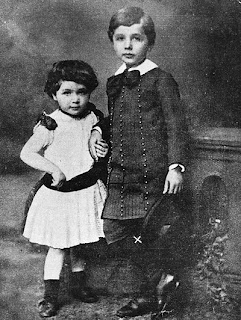Albert Einstein was born in Ulm, in the Kingdom of Württemberg in the German Empire on 14 March 1879.
His father was Hermann Einstein, a salesman and engineer. His mother was Pauline Einstein (née Koch). In 1880, the family moved to Munich, where his father and his uncle founded Elektrotechnische Fabrik J. Einstein & Cie, a company that manufactured electrical equipment based on direct current.
Studio photo of a boy seated in a relaxed posture and wearing a suit, posed in front of a backdrop of scenery.
Albert Einstein in 1893 (age 14).
The Einsteins were non-observant Jews. Their son attended a Catholic elementary school from the age of five until ten.
Although Einstein had early speech difficulties, he was a top student in elementary school.
His father once showed him a pocket compass; Einstein realized that there must be something causing the needle to move, despite the apparent "empty space".
As he grew, Einstein built models and mechanical devices for fun and began to show a talent for mathematics.
In 1889, Max Talmud (later changed to Max Talmey) introduced the ten-year old Einstein to key texts in science, mathematics and philosophy, including Immanuel Kant's Critique of Pure Reason and Euclid's Elements (which Einstein called the "holy little geometry book").
Talmud was a poor Jewish medical student from Poland. The Jewish community arranged for Talmud to take meals with the Einsteins each week on Thursdays for six years. During this time Talmud wholeheartedly guided Einstein through many secular educational interests.
In 1894, his father's company failed: direct current (DC) lost the War of Currents to alternating current (AC). In search of business, the Einstein family moved to Italy, first to Milan and then, a few months later, to Pavia. When the family moved to Pavia, Einstein stayed in Munich to finish his studies at the Luitpold Gymnasium (see de:Albert-Einstein-Gymnasium München). His father intended for him to pursue electrical engineering, but Einstein clashed with authorities and resented the school's regimen and teaching method. He later wrote that the spirit of learning and creative thought were lost in strict rote learning. In the spring of 1895, he withdrew to join his family in Pavia, convincing the school to let him go by using a doctor's note.
During this time, Einstein wrote his first scientific work, "The Investigation of the State of Aether in Magnetic Fields".
Einstein applied directly to the Eidgenössische Polytechnische Schule (ETH) in Zurich, Switzerland. Lacking the requisite Matura certificate, he took an entrance examination, which he failed, although he got exceptional marks in mathematics and physics.
The Einsteins sent Albert to Aarau, in northern Switzerland to finish secondary school.
While lodging with the family of Professor Jost Winteler, he fell in love with Winteler's daughter, Marie. (His sister Maja later married the Wintelers' son, Paul.)
In Aarau, Einstein studied Maxwell's electromagnetic theory. At age 17, he graduated, and, with his father's approval, renounced his citizenship in the German Kingdom of Württemberg to avoid military service, and in 1896 he enrolled in the four year mathematics and physics teaching diploma program at the Polytechnic in Zurich. Marie Winteler moved to Olsberg, Switzerland for a teaching post.
Einstein's future wife, Mileva Marić, also enrolled at the Polytechnic that same year, the only woman among the six students in the mathematics and physics section of the teaching diploma course. Over the next few years, Einstein and Marić's friendship developed into romance, and they read books together on extra-curricular physics in which Einstein was taking an increasing interest. In 1900 Einstein was awarded the Zurich Polytechnic teaching diploma, but Marić failed the examination with a poor grade in the mathematics component, theory of functions.
There have been claims that Marić collaborated with Einstein on his celebrated 1905 papers,but historians of physics who have studied the issue find no evidence that she made any substantive contributions.







